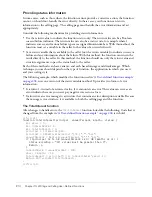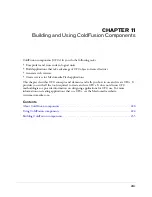
About ColdFusion components
221
This chapter describes how to use CFC object-oriented features. It does not discuss general
object-oriented programming concepts or methods.
When to use CFCs
You can use CFCs in several ways:
•
To develop structured, reusable ColdFusion code
•
To create web services
•
To create elements that can be called by Flash clients
•
To create services that are accessed directly using a URL or form field
Developing structured, reusable code
Like other CFML code reuse techniques, such as user-defined functions (UDFs) and custom tags,
components let you create application functionality that can be reused wherever you need it. If
you want to modify, add, or remove component functionality, you make changes in only one
component file.
Like UDFs and custom tags, CFCs provide an excellent method for developing structured
applications that separate display elements from logical elements and encapsulate database
queries.
CFCs have several advantages over UDFs and custom tags. The advantages include all the
following "extras" that CFCs automatically provide. (Later sections describe these features in
detail.)
•
The ability to group related functions into a single component, and to group related
components into a package
•
Properties that can be shared by multiple functions
•
The This scope, a component-specific scope
•
Inheritance of component methods and properties from a base component, including the use
of the Super keyword
•
Access control
•
Introspection into CFC functions, properties, and metadata
CFCs have one characteristic that prevents them from being the automatic choice for all code
reuse: it takes substantially more processing time to instantiate a CFC than to process a custom
tag (and it takes substantially more time to process a custom tag than to execute a user-defined
function (UDF)). However, after a CFC is instantiated, calling a CFC method has about the same
processing overhead as an equivalent custom tag. As a result, you should not use CFCs in place of
independent, single-purpose, custom tags or UDFs. Instead, you should use CFCs to create
bodies of related methods, particularly methods that share properties.
For more information about UDFs, custom tags, and other ColdFusion code reuse techniques,
see
Chapter 8, “Reusing Code in ColdFusion Pages,” on page 163
.
Содержание ColdFusion MX
Страница 1: ...Developing ColdFusion MX Applications...
Страница 22: ...22 Contents...
Страница 38: ......
Страница 52: ...52 Chapter 2 Elements of CFML...
Страница 162: ......
Страница 218: ...218 Chapter 10 Writing and Calling User Defined Functions...
Страница 250: ...250 Chapter 11 Building and Using ColdFusion Components...
Страница 264: ...264 Chapter 12 Building Custom CFXAPI Tags...
Страница 266: ......
Страница 314: ...314 Chapter 14 Handling Errors...
Страница 344: ...344 Chapter 15 Using Persistent Data and Locking...
Страница 349: ...About user security 349...
Страница 357: ...Security scenarios 357...
Страница 370: ...370 Chapter 16 Securing Applications...
Страница 388: ...388 Chapter 17 Developing Globalized Applications...
Страница 408: ...408 Chapter 18 Debugging and Troubleshooting Applications...
Страница 410: ......
Страница 426: ...426 Chapter 19 Introduction to Databases and SQL...
Страница 476: ...476 Chapter 22 Using Query of Queries...
Страница 534: ...534 Chapter 24 Building a Search Interface...
Страница 556: ...556 Chapter 25 Using Verity Search Expressions...
Страница 558: ......
Страница 582: ...582 Chapter 26 Retrieving and Formatting Data...
Страница 668: ......
Страница 734: ...734 Chapter 32 Using Web Services...
Страница 760: ...760 Chapter 33 Integrating J2EE and Java Elements in CFML Applications...
Страница 786: ...786 Chapter 34 Integrating COM and CORBA Objects in CFML Applications...
Страница 788: ......
Страница 806: ...806 Chapter 35 Sending and Receiving E Mail...
















































